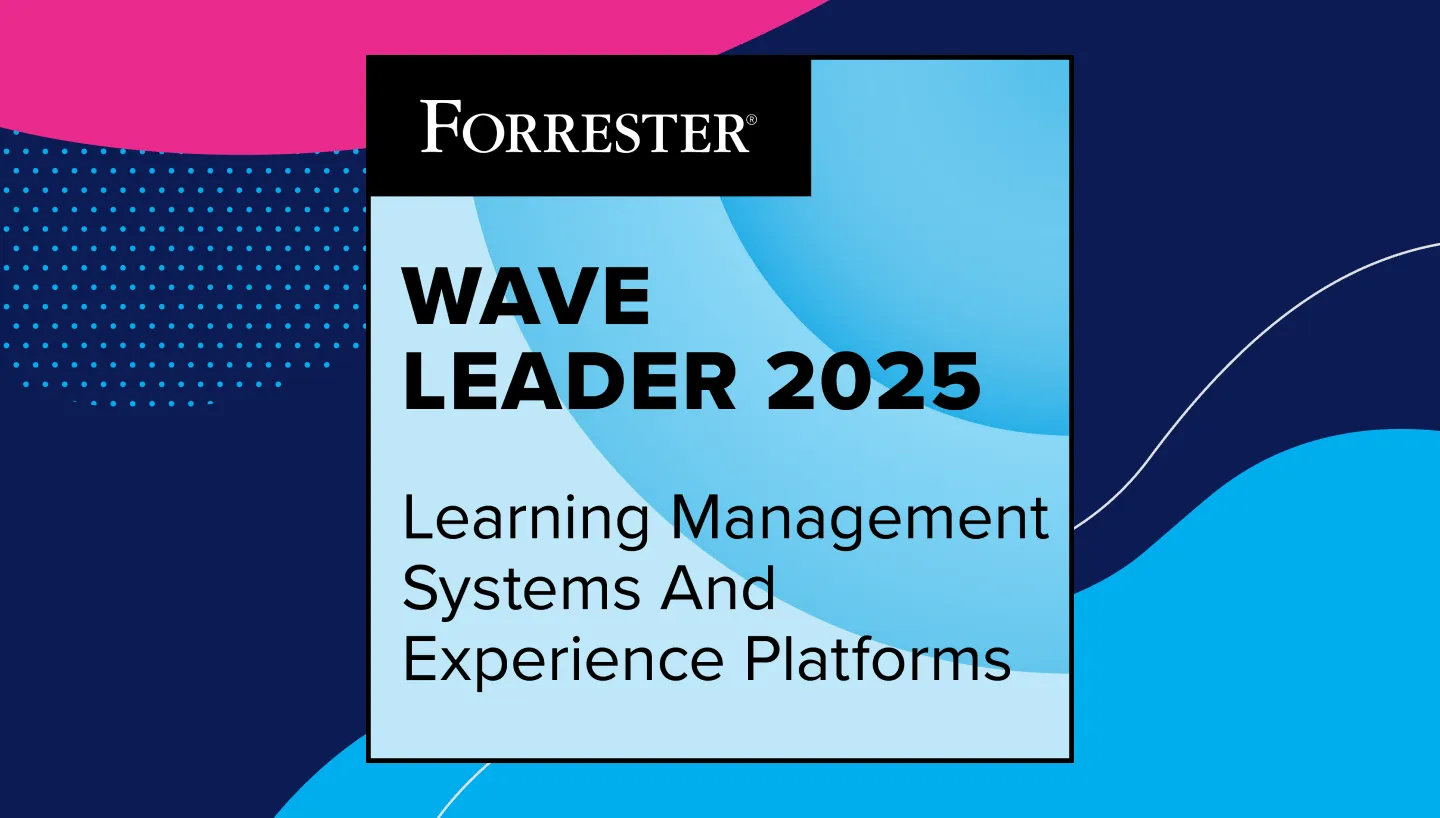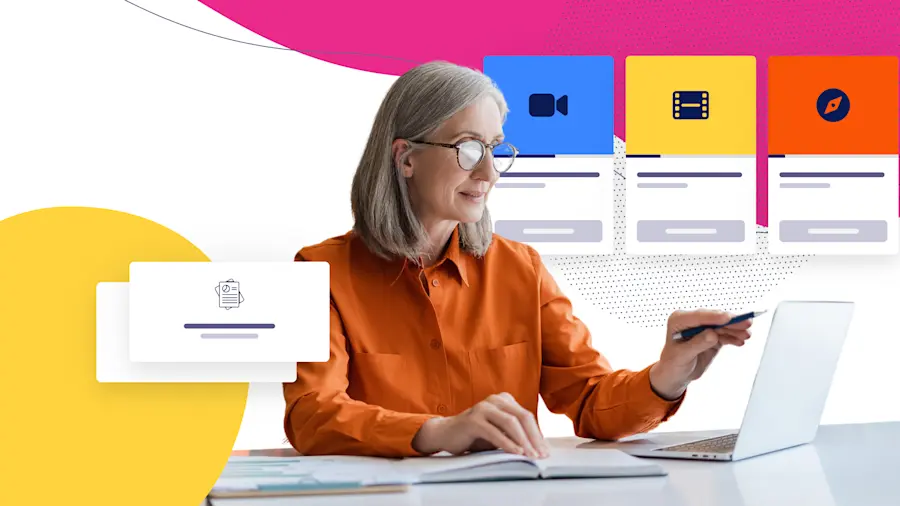eLearning has become the prevailing approach to employee onboarding, compliance training, and professional development. The efficiencies that eLearning affords stem from automation, customization and self-service. These attributes allow end users (employees and others) to access just the right training at just the right time. They also provide Learning and Development administrators the peace of mind that training will be delivered as needed, in a consistent manner and that tracking the progress of individuals will also be made simpler by automation.
But great eLearning content won't deliver itself; an organization needs a powerful learning management system (LMS) to capitalize on this digital potential. The LMS is the "hub" of eLearning and allows for the development, delivery, administration, documentation, tracking and reporting of courses online.
Given all that an LMS can do, however, it is extremely important to choose one that fits both the current and anticipated future needs of your organization. So how do you do that? Our self-service guide answers this question, covering the most important considerations for selecting the right LMS. We'll cover:
- What is your organization trying to achieve with an LMS?
- How will eLearning content and IT infrastructure support needs across geographies?
- What can be assumed regarding learner sophistication and engagement?
- What do administrators need to be successful?
- What integrations with other applications are needed?
- What are the expectations for product and technical support?
Plus, what to keep in mind during an LMS evaluation and how to get the most out of your LMS!
We invite you to start by stepping through this guided exploration of LMS requirements, designed to help you identify the characteristics that are most important to your company in administering training to your unique community of learners. Then, if you still have questions, or if you just want to speak to an LMS expert, we invite you to connect with us to see how Absorb LMS can meet your company's needs.
1. What is our organization trying to achieve with an LMS?
Put together a list of learning objectives and training goals to understand how the LMS will help you achieve Start with the most basic question: what are the particular pain points that we need an LMS to address?
If that sounds a bit too broad, try these guiding questions to help focus your requirements:
- Will we be training an internal audience only (employees)? Or do we need our LMS to orchestrate training for external users as well, including partners, independent contractors, association members, vendors and/or customers?
- Are we looking for an LMS that can help with onboarding new employees?
- Do we need an LMS that can coordinate mandated compliance training?
- Do we anticipate utilizing an LMS to manage ongoing professional development?
- Do we intend to sell eLearning courses?
- Do we envision delivering live, instructor-led courses (ILCs)? Will we be delivering on- demand, online courseware? Do we need the flexibility to do both?
Understand that your company's goals may change over time, and while it's important to ensure immediate and long-term objectives are being met, it's also worth knowing the full capabilities of the LMS. Knowing how your company could grow into, and benefit from, other features could be important down the road.
2. How will our eLearning content and our IT infrastructure support our needs across geographies?
Generally speaking, every LMS today offers a cloud-based solution. That said, it's important to think through how your organization's geographic distribution now and in the future may inform your LMS requirements. Those who assume that "web- based" means the solution will be ubiquitously accessible anywhere the Internet is available may be overlooking a few important considerations that could impact the user experience at a global level.
Great eLearning content won't deliver itself; an organization needs a powerful LMS to capitalize on this digital potential
Depending on a learner's Internet connection speed and strength, content may load slower for some users than others. Your IT organization should be able to consult with you on how to optimize the delivery of eLearning content across your company's network topology. Further, your company may require that your data is only stored in the same country as your operations due to legal, security or other reasons.
Seek your IT department's input on the following to see how they might affect your choice of LMS:
- Internet speed, firewalls, internet provider, speed and connection stability
- Browser compatibility
- Network settings and policies affecting the use of a cloud-based LMS (e.g., URL, content type, pop-up blockers, IP address whitelisting, etc.)
- Mobile endpoint management
- Computing hardware and software compatibility with eLearning courseware
3. What can we assume regarding learner sophistication and engagement?
Understanding the user base is important as a user experience that is mismatched with the learner's technical proficiency can significantly affect the adoption of the LMS and the overall success of your eLearning initiatives. It's always wise to look for an LMS with a user-friendly and intuitive user interface. Even sophisticated users will appreciate being able to navigate the LMS quickly and efficiently.
Other considerations include:
- Are our learners used to working with computers and/or mobile devices? Or are they rarely utilizing such technology in their job functions?
- Can we assume that the baseline facility with technology that our learner groups have today will be the same in six months, one year, or five years?
- What do we want to be able to offer our learners to keep them engaged in a culture of continuous learning?
It stands to reason that the more engaged a learner is in his or her training, the more likely the learner will be to go further in the training and the more likely he or she will be to retain the information delivered. So, it's important to evaluate an LMS from the perspective of learner engagement to see whether the solution will meet your needs. Explore the features and functionality built into the LMS specifically to boost learner engagement.
4. What do our administrators need to be successful?
It's important to accurately assess the skill set of your Learning and Development team. Is this their first LMS experience? Or is the L&D team familiar and well versed with the ins and outs of LMS? Inexperienced administrators may require more time to familiarize themselves with your chosen solution than those who have used an LMS before. Similar to your learners, administrators of any level of experience will appreciate having an interface that is straightforward with efficient workflows.
- How proficient is our Learning and Development (L&D) team in LMS technology?
- What needs do we have in terms of tracking and reporting on progress of our eLearning initiatives?
It is also important to establish a baseline expectation for the reporting your organization will require of your L&D team. Will you be required to report on high-level metrics around courses taken and users trained? Or will the L&D team be expected to generate granular reports on the training activities of segments of your learner population narrowed by multiple criteria? Be sure to fully explore the reporting capabilities and limitations of any LMS solution you are considering.
5. What integrations with other applications do we need?
With the explosion in popularity of application programming interfaces (APIs), technical integrations between applications are vastly improving the efficiency and enhancing the functionality of enterprise applications. You can further define your requirements by asking a few questions that touch more broadly on the functions of your company's business units:
- What enterprise applications access data that our LMS might need to share?
- What integrations with other applications do we need now or will we need in the near future?
- Do we want to be able to develop our own custom integrations with the LMS?
Once you know what other applications you might want to have share data with your LMS, you can better determine whether the integrations supported by a given LMS provider meet your company's needs. These might include integrations such as SSO, HRIS, Active Directory, or CRM. Does the LMS offer an API your company can use? Think through how frequently syncing needs to happen; is it instant, daily, weekly, or monthly?
Technology is constantly evolving and it's important that the LMS provider keeps its solution current with emerging capabilities
It's also important to define the requirement around the support that your organization will be expected to provide. Ask LMS vendors about their fees and support for these integrations.
6. What do we expect for product and technical support?
In a business environment where digital products in market are never "finished" and are constantly being refined and improved, ongoing product and technical support remain among the most important indicators of a customer's satisfaction with their chosen LMS solution. Make sure to establish a clear expectation for the type of support the LMS vendor will offer and how it will be delivered:
- When and how should we be able to contact Customer Support?
- Can we expect support to be provided via phone, email, support tickets, and/or a support portal?
When evaluating LMS solutions, it's important to ask for a copy of their Service Level Agreement (SLA) and understand how each LMS provider rates and escalates issues and concerns. It's also important to understand the level of training and support they offer for the implementation phase in addition to the on-going support phase.
- What can we expect in terms of ongoing LMS improvement?
Technology is constantly evolving and it's important that the LMS provider keeps its solution current with emerging capabilities. Any LMS provider should be able to tell you how and when they will update the LMS with new features and functionality. Ask about their roadmap for the future and how they handle downtimes for updates. It's also worth asking what improvements and updates they rolled out in the past two years. This should be a good indicator of their commitment to ongoing improvement.
Evaluating LMS Solutions
As with any important purchase, each company has a different process to narrow down to a specific product selection. Here are a few steps that we recommend:
Research
First, start researching and create a list of five to ten LMS solutions that seem to fit your requirements. Utilize sites like https://www.capterra.com, which provide LMS and other software reviews, to help you research unbiased opinions. You can also try searching industry organizations like the following for their picks and reviews:
- Gartner.com
- TrainingIndustry.com
- eLearningIndustry.com
- G2Crowd.com
Demo
Once the search has been narrowed, reach out to the LMS companies and ask for demonstrations. It's best to coordinate and have a few of your company's stakeholders attend the demos. This way, there are multiple sets of eyes and ears taking in the information, and they can ask questions from their unique perspectives that address their particular pain points. This will help further refine your list of requirements and will help weed out solutions that won't work for you.
The RFP
Some company policies require going through an RFP or RFI process. Your company may already have its own RFP/RFI template. If not, however, there are plenty of existing templates available that you can utilize. Good RFP/RFI templates share the following attributes:
- The templates are short -- just a few pages.
- They ask only essential questions.
- They list must-have requirements up front.
- They show respect for the LMS vendor's time.
As with any important decision, be sure to include and share information with decision makers and stakeholders throughout the LMS search process. We've seen organizations get halfway through their LMS search only to find they had forgotten to include a stakeholder whose requirements significantly change the type of LMS they need. This meant they had to go back to the beginning and start the process over. This is not only discouraging but also costs time and money.
Getting the most out of your LMS
Choosing an LMS that you will be as happy with in 5 years as at the beginning is a significant undertaking. The more you can do today to define your requirements, the more likely you will be to select a solution that you will be happy with for years to come. As you bring together company stakeholders to identify your eLearning and LMS needs, remember to take into account each of the following considerations:
- Determine your company's needs: Take time and ensure that you've accurately assessed your company's requirements in terms
of eLearning content, method of delivery, geography of your learners, proficiency of both learners and administrators, and
product and customer support. This will help you to develop the right training strategy for your company.
- Involve Human Resources: Access and plan your administration and training resources appropriately. Train, upskill and hire as needed.
- Weigh out current vs. future requirements and plan for growth: Understand that your company's needs will change in the coming years.
- Keep course content current and relevant: Develop a plan to review, update and maintain your courses on a regular basis.
- Expand LMS functionality with technical integrations: Investigate how you can integrate your LMS with your current systems
If you're ready to discuss your LMS requirements with an expert, or you want help in the requirements definition process, talk to us about how Absorb LMS can meet your company's needs.







